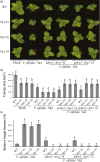Transfer of tomato immune receptor Ve1 confers Ave1-dependent Verticillium resistance in tobacco and cotton
- PMID: 28796297
- PMCID: PMC5787823
- DOI: 10.1111/pbi.12804
Transfer of tomato immune receptor Ve1 confers Ave1-dependent Verticillium resistance in tobacco and cotton
Abstract
Verticillium wilts caused by soilborne fungal species of the Verticillium genus are economically important plant diseases that affect a wide range of host plants and are notoriously difficult to combat. Perception of pathogen(-induced) ligands by plant immune receptors is a key component of plant innate immunity. In tomato, race-specific resistance to Verticillium wilt is governed by the cell surface-localized immune receptor Ve1 through recognition of the effector protein Ave1 that is secreted by race 1 strains of Verticillium spp. It was previously demonstrated that transgenic expression of tomato Ve1 in the model plant Arabidopsis thaliana leads to Verticillium wilt resistance. Here, we investigated whether tomato Ve1 can confer Verticillium resistance when expressed in the crop species tobacco (Nicotiana tabcum) and cotton (Gossypium hirsutum). We show that transgenic tobacco and cotton plants constitutively expressing tomato Ve1 exhibit enhanced resistance against Verticillium wilt in an Ave1-dependent manner. Thus, we demonstrate that the functionality of tomato Ve1 in Verticillium wilt resistance through recognition of the Verticillium effector Ave1 is retained after transfer to tobacco and cotton, implying that the Ve1-mediated immune signalling pathway is evolutionary conserved across these plant species. Moreover, our results suggest that transfer of tomato Ve1 across sexually incompatible plant species can be exploited in breeding programmes to engineer Verticillium wilt resistance.
Keywords: cell surface receptor; pathogen resistance; receptor-like protein; vascular wilt; verticillium dahliae.
© 2017 The Authors. Plant Biotechnology Journal published by Society for Experimental Biology and The Association of Applied Biologists and John Wiley & Sons Ltd.
Figures





References
-
- Afroz, A. , Chaudhry, Z. , Rashid, U. , Ali, G.M. , Nazir, F. , Iqbal, J. and Khan, M.R. (2011) Enhanced resistance against bacterial wilt in transgenic tomato (Lycopersicon esculentum) lines expressing the Xa21 gene. Plant Cell, Tissue Organ Cult. 104, 227–237.
-
- Agrios, G. (2005) Plant Pathology, 5th edn. New York: Elsevier Academic Press.
-
- Albert, I. , Böhm, H. , Albert, M. , Feiler, C.E. , Imkampe, J. , Wallmeroth, N. , Brancato, C. et al. (2015) An RLP23–SOBIR1–BAK1 complex mediates NLP‐triggered immunity. Nat. Plants 1, 15140. - PubMed
-
- Barrow, J.R. (1970) Heterozygosity in inheritance of Verticillium wilt tolerance in cotton. Phytopathology, 60, 301–303.
Publication types
MeSH terms
Associated data
- Actions
- Actions
LinkOut - more resources
Full Text Sources
Other Literature Sources
Miscellaneous

